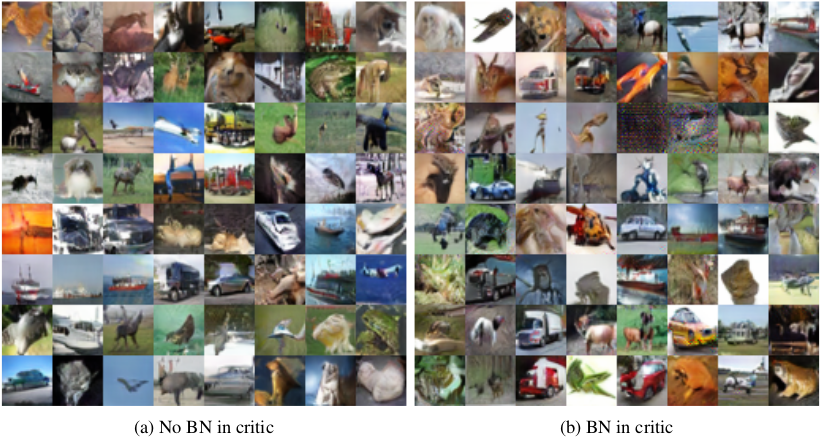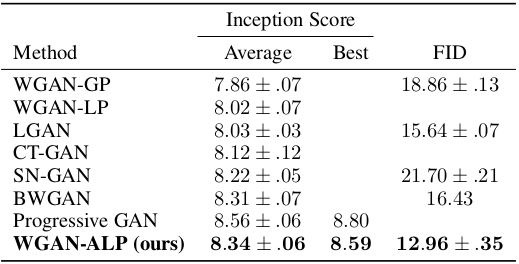Adversarial Lipschitz Regularization
By Dávid Terjék†
†Robert Bosch Kft.
Presented By
Andreas Munk
amunk@cs.ubc.ca
Nov 20, 2020
Table of Contents
- Penalization of Lipschitz constraint violation cite:terjek2020adversarial
- Generative adversarial networks (GANS) cite:goodfellow2014generative
- Wasserstein GAN cite:arjovsky2017wasserstein
- Improved Wasserstein GAN (WGAN-GP) cite:gulrajani2017improved
- Can we do better?
- Adversarial Lipschitz regularization (ALR) cite:terjek2020adversarial
- WGAN-ALP
- Experiments
- Remaining issues
- References
\( \newcommand{\ie}{i.e.} \newcommand{\eg}{e.g.} \newcommand{\etal}{\textit{et~al.}} \newcommand{\wrt}{w.r.t.} \newcommand{\bra}[1]{\langle #1 \mid} \newcommand{\ket}[1]{\mid #1\rangle} \newcommand{\braket}[2]{\langle #1 \mid #2 \rangle} \newcommand{\bigbra}[1]{\big\langle #1 \big\mid} \newcommand{\bigket}[1]{\big\mid #1 \big\rangle} \newcommand{\bigbraket}[2]{\big\langle #1 \big\mid #2 \big\rangle} \newcommand{\grad}{\boldsymbol{\nabla}} \newcommand{\divop}{\grad\scap} \newcommand{\pp}{\partial} \newcommand{\ppsqr}{\partial^2} \renewcommand{\vec}[1]{\boldsymbol{#1}} \newcommand{\trans}[1]{#1^\mr{T}} \newcommand{\dm}{\,\mathrm{d}} \newcommand{\complex}{\mathbb{C}} \newcommand{\real}{\mathbb{R}} \newcommand{\krondel}[1]{\delta_{#1}} \newcommand{\limit}[2]{\mathop{\longrightarrow}_{#1 \rightarrow #2}} \newcommand{\measure}{\mathbb{P}} \newcommand{\scap}{\!\cdot\!} \newcommand{\intd}[1]{\int\!\dm#1\: } \newcommand{\ave}[1]{\left\langle #1 \right\rangle} \newcommand{\br}[1]{\left\lbrack #1 \right\rbrack} \newcommand{\paren}[1]{\left(#1\right)} \newcommand{\tub}[1]{\left\{#1\right\}} \newcommand{\mr}[1]{\mathrm{#1}} \newcommand{\evalat}[1]{\left.#1\right\vert} \newcommand*{\given}{\mid} \newcommand{\abs}[1]{\left\lvert#1\right\rvert} \newcommand{\norm}[1]{\left\lVert#1\right\rVert} \newcommand{\figleft}{\em (Left)} \newcommand{\figcenter}{\em (Center)} \newcommand{\figright}{\em (Right)} \newcommand{\figtop}{\em (Top)} \newcommand{\figbottom}{\em (Bottom)} \newcommand{\captiona}{\em (a)} \newcommand{\captionb}{\em (b)} \newcommand{\captionc}{\em (c)} \newcommand{\captiond}{\em (d)} \newcommand{\newterm}[1]{\bf #1} \def\ceil#1{\lceil #1 \rceil} \def\floor#1{\lfloor #1 \rfloor} \def\1{\boldsymbol{1}} \newcommand{\train}{\mathcal{D}} \newcommand{\valid}{\mathcal{D_{\mathrm{valid}}}} \newcommand{\test}{\mathcal{D_{\mathrm{test}}}} \def\eps{\epsilon} \def\reta{\textnormal{$\eta$}} \def\ra{\textnormal{a}} \def\rb{\textnormal{b}} \def\rc{\textnormal{c}} \def\rd{\textnormal{d}} \def\re{\textnormal{e}} \def\rf{\textnormal{f}} \def\rg{\textnormal{g}} \def\rh{\textnormal{h}} \def\ri{\textnormal{i}} \def\rj{\textnormal{j}} \def\rk{\textnormal{k}} \def\rl{\textnormal{l}} \def\rn{\textnormal{n}} \def\ro{\textnormal{o}} \def\rp{\textnormal{p}} \def\rq{\textnormal{q}} \def\rr{\textnormal{r}} \def\rs{\textnormal{s}} \def\rt{\textnormal{t}} \def\ru{\textnormal{u}} \def\rv{\textnormal{v}} \def\rw{\textnormal{w}} \def\rx{\textnormal{x}} \def\ry{\textnormal{y}} \def\rz{\textnormal{z}} \def\rvepsilon{\mathbf{\epsilon}} \def\rvtheta{\mathbf{\theta}} \def\rva{\mathbf{a}} \def\rvb{\mathbf{b}} \def\rvc{\mathbf{c}} \def\rvd{\mathbf{d}} \def\rve{\mathbf{e}} \def\rvf{\mathbf{f}} \def\rvg{\mathbf{g}} \def\rvh{\mathbf{h}} \def\rvu{\mathbf{i}} \def\rvj{\mathbf{j}} \def\rvk{\mathbf{k}} \def\rvl{\mathbf{l}} \def\rvm{\mathbf{m}} \def\rvn{\mathbf{n}} \def\rvo{\mathbf{o}} \def\rvp{\mathbf{p}} \def\rvq{\mathbf{q}} \def\rvr{\mathbf{r}} \def\rvs{\mathbf{s}} \def\rvt{\mathbf{t}} \def\rvu{\mathbf{u}} \def\rvv{\mathbf{v}} \def\rvw{\mathbf{w}} \def\rvx{\mathbf{x}} \def\rvy{\mathbf{y}} \def\rvz{\mathbf{z}} \def\erva{\textnormal{a}} \def\ervb{\textnormal{b}} \def\ervc{\textnormal{c}} \def\ervd{\textnormal{d}} \def\erve{\textnormal{e}} \def\ervf{\textnormal{f}} \def\ervg{\textnormal{g}} \def\ervh{\textnormal{h}} \def\ervi{\textnormal{i}} \def\ervj{\textnormal{j}} \def\ervk{\textnormal{k}} \def\ervl{\textnormal{l}} \def\ervm{\textnormal{m}} \def\ervn{\textnormal{n}} \def\ervo{\textnormal{o}} \def\ervp{\textnormal{p}} \def\ervq{\textnormal{q}} \def\ervr{\textnormal{r}} \def\ervs{\textnormal{s}} \def\ervt{\textnormal{t}} \def\ervu{\textnormal{u}} \def\ervv{\textnormal{v}} \def\ervw{\textnormal{w}} \def\ervx{\textnormal{x}} \def\ervy{\textnormal{y}} \def\ervz{\textnormal{z}} \def\rmA{\mathbf{A}} \def\rmB{\mathbf{B}} \def\rmC{\mathbf{C}} \def\rmD{\mathbf{D}} \def\rmE{\mathbf{E}} \def\rmF{\mathbf{F}} \def\rmG{\mathbf{G}} \def\rmH{\mathbf{H}} \def\rmI{\mathbf{I}} \def\rmJ{\mathbf{J}} \def\rmK{\mathbf{K}} \def\rmL{\mathbf{L}} \def\rmM{\mathbf{M}} \def\rmN{\mathbf{N}} \def\rmO{\mathbf{O}} \def\rmP{\mathbf{P}} \def\rmQ{\mathbf{Q}} \def\rmR{\mathbf{R}} \def\rmS{\mathbf{S}} \def\rmT{\mathbf{T}} \def\rmU{\mathbf{U}} \def\rmV{\mathbf{V}} \def\rmW{\mathbf{W}} \def\rmX{\mathbf{X}} \def\rmY{\mathbf{Y}} \def\rmZ{\mathbf{Z}} \def\ermA{\textnormal{A}} \def\ermB{\textnormal{B}} \def\ermC{\textnormal{C}} \def\ermD{\textnormal{D}} \def\ermE{\textnormal{E}} \def\ermF{\textnormal{F}} \def\ermG{\textnormal{G}} \def\ermH{\textnormal{H}} \def\ermI{\textnormal{I}} \def\ermJ{\textnormal{J}} \def\ermK{\textnormal{K}} \def\ermL{\textnormal{L}} \def\ermM{\textnormal{M}} \def\ermN{\textnormal{N}} \def\ermO{\textnormal{O}} \def\ermP{\textnormal{P}} \def\ermQ{\textnormal{Q}} \def\ermR{\textnormal{R}} \def\ermS{\textnormal{S}} \def\ermT{\textnormal{T}} \def\ermU{\textnormal{U}} \def\ermV{\textnormal{V}} \def\ermW{\textnormal{W}} \def\ermX{\textnormal{X}} \def\ermY{\textnormal{Y}} \def\ermZ{\textnormal{Z}} \def\vzero{\boldsymbol{0}} \def\vone{\boldsymbol{1}} \def\vmu{\boldsymbol{\mu}} \def\vtheta{\boldsymbol{\theta}} \def\va{\boldsymbol{a}} \def\vb{\boldsymbol{b}} \def\vc{\boldsymbol{c}} \def\vd{\boldsymbol{d}} \def\ve{\boldsymbol{e}} \def\vf{\boldsymbol{f}} \def\vg{\boldsymbol{g}} \def\vh{\boldsymbol{h}} \def\vi{\boldsymbol{i}} \def\vj{\boldsymbol{j}} \def\vk{\boldsymbol{k}} \def\vl{\boldsymbol{l}} \def\vm{\boldsymbol{m}} \def\vn{\boldsymbol{n}} \def\vo{\boldsymbol{o}} \def\vp{\boldsymbol{p}} \def\vq{\boldsymbol{q}} \def\vr{\boldsymbol{r}} \def\vs{\boldsymbol{s}} \def\vt{\boldsymbol{t}} \def\vu{\boldsymbol{u}} \def\vv{\boldsymbol{v}} \def\vw{\boldsymbol{w}} \def\vx{\boldsymbol{x}} \def\vy{\boldsymbol{y}} \def\vz{\boldsymbol{z}} \def\evalpha{\alpha} \def\evbeta{\beta} \def\evepsilon{\epsilon} \def\evlambda{\lambda} \def\evomega{\omega} \def\evmu{\mu} \def\evpsi{\psi} \def\evsigma{\sigma} \def\evtheta{\theta} \def\eva{a} \def\evb{b} \def\evc{c} \def\evd{d} \def\eve{e} \def\evf{f} \def\evg{g} \def\evh{h} \def\evi{i} \def\evj{j} \def\evk{k} \def\evl{l} \def\evm{m} \def\evn{n} \def\evo{o} \def\evp{p} \def\evq{q} \def\evr{r} \def\evs{s} \def\evt{t} \def\evu{u} \def\evv{v} \def\evw{w} \def\evx{x} \def\evy{y} \def\evz{z} \def\mA{\boldsymbol{A}} \def\mB{\boldsymbol{B}} \def\mC{\boldsymbol{C}} \def\mD{\boldsymbol{D}} \def\mE{\boldsymbol{E}} \def\mF{\boldsymbol{F}} \def\mG{\boldsymbol{G}} \def\mH{\boldsymbol{H}} \def\mI{\boldsymbol{I}} \def\mJ{\boldsymbol{J}} \def\mK{\boldsymbol{K}} \def\mL{\boldsymbol{L}} \def\mM{\boldsymbol{M}} \def\mN{\boldsymbol{N}} \def\mO{\boldsymbol{O}} \def\mP{\boldsymbol{P}} \def\mQ{\boldsymbol{Q}} \def\mR{\boldsymbol{R}} \def\mS{\boldsymbol{S}} \def\mT{\boldsymbol{T}} \def\mU{\boldsymbol{U}} \def\mV{\boldsymbol{V}} \def\mW{\boldsymbol{W}} \def\mX{\boldsymbol{X}} \def\mY{\boldsymbol{Y}} \def\mZ{\boldsymbol{Z}} \def\mBeta{\boldsymbol{\beta}} \def\mPhi{\boldsymbol{\Phi}} \def\mLambda{\boldsymbol{\Lambda}} \def\mSigma{\boldsymbol{\Sigma}} \def\gA{\mathcal{A}} \def\gB{\mathcal{B}} \def\gC{\mathcal{C}} \def\gD{\mathcal{D}} \def\gE{\mathcal{E}} \def\gF{\mathcal{F}} \def\gG{\mathcal{G}} \def\gH{\mathcal{H}} \def\gI{\mathcal{I}} \def\gJ{\mathcal{J}} \def\gK{\mathcal{K}} \def\gL{\mathcal{L}} \def\gM{\mathcal{M}} \def\gN{\mathcal{N}} \def\gO{\mathcal{O}} \def\gP{\mathcal{P}} \def\gQ{\mathcal{Q}} \def\gR{\mathcal{R}} \def\gS{\mathcal{S}} \def\gT{\mathcal{T}} \def\gU{\mathcal{U}} \def\gV{\mathcal{V}} \def\gW{\mathcal{W}} \def\gX{\mathcal{X}} \def\gY{\mathcal{Y}} \def\gZ{\mathcal{Z}} \def\sA{\mathbb{A}} \def\sB{\mathbb{B}} \def\sC{\mathbb{C}} \def\sD{\mathbb{D}} \def\sF{\mathbb{F}} \def\sG{\mathbb{G}} \def\sH{\mathbb{H}} \def\sI{\mathbb{I}} \def\sJ{\mathbb{J}} \def\sK{\mathbb{K}} \def\sL{\mathbb{L}} \def\sM{\mathbb{M}} \def\sN{\mathbb{N}} \def\sO{\mathbb{O}} \def\sP{\mathbb{P}} \def\sQ{\mathbb{Q}} \def\sR{\mathbb{R}} \def\sS{\mathbb{S}} \def\sT{\mathbb{T}} \def\sU{\mathbb{U}} \def\sV{\mathbb{V}} \def\sW{\mathbb{W}} \def\sX{\mathbb{X}} \def\sY{\mathbb{Y}} \def\sZ{\mathbb{Z}} \def\emLambda{\Lambda} \def\emA{A} \def\emB{B} \def\emC{C} \def\emD{D} \def\emE{E} \def\emF{F} \def\emG{G} \def\emH{H} \def\emI{I} \def\emJ{J} \def\emK{K} \def\emL{L} \def\emM{M} \def\emN{N} \def\emO{O} \def\emP{P} \def\emQ{Q} \def\emR{R} \def\emS{S} \def\emT{T} \def\emU{U} \def\emV{V} \def\emW{W} \def\emX{X} \def\emY{Y} \def\emZ{Z} \def\emSigma{\Sigma} \newcommand{\etens}[1]{\mathsfit{#1}} \def\etLambda{\etens{\Lambda}} \def\etA{\etens{A}} \def\etB{\etens{B}} \def\etC{\etens{C}} \def\etD{\etens{D}} \def\etE{\etens{E}} \def\etF{\etens{F}} \def\etG{\etens{G}} \def\etH{\etens{H}} \def\etI{\etens{I}} \def\etJ{\etens{J}} \def\etK{\etens{K}} \def\etL{\etens{L}} \def\etM{\etens{M}} \def\etN{\etens{N}} \def\etO{\etens{O}} \def\etP{\etens{P}} \def\etQ{\etens{Q}} \def\etR{\etens{R}} \def\etS{\etens{S}} \def\etT{\etens{T}} \def\etU{\etens{U}} \def\etV{\etens{V}} \def\etW{\etens{W}} \def\etX{\etens{X}} \def\etY{\etens{Y}} \def\etZ{\etens{Z}} \newcommand{\pdata}{p_{\rm{data}}} \newcommand{\ptrain}{\hat{p}_{\rm{data}}} \newcommand{\Ptrain}{\hat{P}_{\rm{data}}} \newcommand{\pmodel}{p_{\rm{model}}} \newcommand{\Pmodel}{P_{\rm{model}}} \newcommand{\ptildemodel}{\tilde{p}_{\rm{model}}} \newcommand{\pencode}{p_{\rm{encoder}}} \newcommand{\pdecode}{p_{\rm{decoder}}} \newcommand{\precons}{p_{\rm{reconstruct}}} \newcommand{\laplace}{\mathrm{Laplace}} % Laplace distribution \newcommand{\E}{\mathbb{E}} \newcommand{\Ls}{\mathcal{L}} \newcommand{\R}{\mathbb{R}} \newcommand{\emp}{\tilde{p}} \newcommand{\lr}{\alpha} \newcommand{\reg}{\lambda} \newcommand{\rect}{\mathrm{rectifier}} \newcommand{\softmax}{\mathrm{softmax}} \newcommand{\sigmoid}{\sigma} \newcommand{\softplus}{\zeta} \newcommand{\KL}{D_{\mathrm{KL}}} \newcommand{\Var}{\mathrm{Var}} \newcommand{\standarderror}{\mathrm{SE}} \newcommand{\Cov}{\mathrm{Cov}} \newcommand{\normlzero}{L^0} \newcommand{\normlone}{L^1} \newcommand{\normltwo}{L^2} \newcommand{\normlp}{L^p} \newcommand{\normmax}{L^\infty} \newcommand{\parents}{Pa} % See usage in notation.tex. Chosen to match Daphne's book. \DeclareMathOperator*{\argmax}{arg\,max} \DeclareMathOperator*{\argmin}{arg\,min} \DeclareMathOperator{\sign}{sign} \DeclareMathOperator{\Tr}{Tr} \let\ab\allowbreak \newcommand{\vxlat}{\vx_{\mr{lat}}} \newcommand{\vxobs}{\vx_{\mr{obs}}} \newcommand{\block}[1]{\underbrace{\begin{matrix}1 & \cdots & 1\end{matrix}}_{#1}} \newcommand{\blockt}[1]{\begin{rcases} \begin{matrix} ~\\ ~\\ ~ \end{matrix} \end{rcases}{#1}} \newcommand{\tikzmark}[1]{\tikz[overlay,remember picture] \node (#1) {};} \)
Penalization of Lipschitz constraint violation terjek2020adversarial
- Required for Wasserstein Adversarial Networks arjovsky2017wasserstein
- Explicit regularization was previously thought infeasible petzka2018regularization
Generative adversarial networks (GANS) goodfellow2014generative
- A generator is a neural network \(g:\mZ\rightarrow\mX\subseteq\real^{D_{x}}\) which maps from a random vector \(\vz\in\mZ\) to an output \(\vx \in \mX\)
- \(g\) characterizes a distribution \(p_{\theta}(\vx)\), where \(\theta\in\Theta\subseteq\mathbb{R}^{D_g}\) denotes the generator’s parameters
- Aim is to match \(p_{\theta}\) with some real target distribution \(p_{\mr{real}}\)
- A critic/discriminator \(f_\phi:\mX\rightarrow \mF\) with parameters \(\phi\in\Phi\subseteq\real^{D_f}\)
Generally we frame GANs as a minimax game,
\[\min_{\theta}\max_{\phi}h(p_{\theta},f_\phi)\]
- Originally Goodfellow et al. (2014) defined
\[ h(p_{\theta},f_\phi) = \E_{x\sim p_\mr{true}}\br{\log f_\phi(x)} + \E_{x\sim p_{\theta}}\br{\log (1 - f_\phi(x))}\]
Wasserstein GAN arjovsky2017wasserstein
- Wasserstein Distance \(W_{p}(P_{1},P_{2})=\paren{\inf_{\gamma\in\Gamma(P_{1},P_{2})}\E_{\gamma}\br{d(x_{1},x_{2})^{p}}}^{\frac{1}{p}}\)
- Kantorovich-Rubinstein duality villani2008optimal, \[ W_{1}(P_{1},P_{2}) = \sup_{\norm{f}_{\mr{L}}\leq1}\paren{\E_{P_{1}}\br{f} - \E_{P_{2}}\br{f}} \]
- WGAN: \[ \min_{\theta}\max_{\phi}\E_{p_\mr{true}}\br{f_{\phi}} - \E_{p_{\theta}}\br{f_\phi}, \quad \mr{s.t.}~\norm{f_{\phi}}_{\mr{L}}\leq 1\]
- Notice the Lipschitz constraint \(\norm{f_{\phi}}_{\mr{Lip}}\leq 1\)
- Constraint imposed using weight clipping \(\Phi\subseteq \mW = \br{-w,w}^{D_{f}}\), where \(w\) is some constant
- Ensures global\(^{*}\) Lipschitz continuity with some unknown Lipschitz constant \(L\geq 0\)
- \(^{*}\text{assuming}\) for all \(\phi\in\mW,~f_{\phi}\) is Lipschitz continuous or \(\mX\) is compact
- Generally consider \(LW_{1}(P_{1},P_{2})\)
- Ensures global\(^{*}\) Lipschitz continuity with some unknown Lipschitz constant \(L\geq 0\)
Lipschitz Continuity
Definition: Given two metric spaces \(\paren{\mX, d_{\mX}}\) and \(\paren{\mY, d_{\mY}}\), a function \(f:\mX\rightarrow \mY\) is called Lipschitz continuous is there exists a constant \(L\geq 0\) such that
\[\forall (x,x') \in\mX\times\mX, d_{\mY}(f(x),f(x')) \leq L d_{\mX}(x,x') \]
In particular consider \(\mX\subseteq\real^{D_{x}}\) and \(\mY\subseteq\real^{D_{y}}\) and the Euclidean distance, then
\[\forall (x,x') \in\mX\times\mX, \norm{f(x)-f(x')}_{2} \leq L \norm{x-x'}_{2}\]
- For more information on Lipschitz continuity and deep neural networks, see e.g. virmaux2018lipschitz.
Improved Wasserstein GAN (WGAN-GP) gulrajani2017improved
- Weight clipping reduces the function space
- Soft regularization by considering the Lipschitz constraint with respect to the optimal coupling \(\gamma^{*}\)
- \(\gamma^{*}\) is unknown
- Use interpolated samples \(\tilde{x}\sim p_{i}\) between \(x_{\mr{real}}\) and \(x_{\mr{fake}}\)
- Sample \(x_{\mr{real}}\sim p_{\mr{real}}\), \(x_{\mr{fake}}\sim p_{\theta}\), and do a random interpolation
- New objective using gradient penalties (GP) \[ \min_{\theta}\max_{\phi}\E_{p_\mr{true}}\br{f_{\phi}} - \E_{p_{\theta}}\br{f_\phi} + \lambda\E_{\tilde{x}\sim p_{i}}\br{\paren{\norm{\grad_{\tilde{x}}f_{\phi}(\tilde{x})}_{2} - 1}^{2}} \]
Lipschitz Continuity and Differentiability
Using Theorem 3.1.6 in federer2014geometric, we have that if \(f:\real^{n}\rightarrow\real^{m}\) is locally Lipschitz continuous function, then \(f\) is differentiable almost everywhere (except for a set of Lebesque measure zero). If \(f\) is Lipschitz continuous, then
\[L(f)=\sup_{x\in\real^{n}}\norm{D_{x}f}_{op},\]
where \(\norm{\mX}_{op}=\sup_{\vv:\norm{\vv}=1}\norm{\mX\vv}_{2}\) is the operator norm of \(\mX\in\real^{n\times m}\)
In particular if \(m=1\), then \(D_{x}f = \trans{(\grad_{x}f)}\) and using Cauchy-Schwartz inequality we have,
\[\norm{\trans{(\grad_{x}f)}}_{op}=\sup_{\vv:\norm{\vv}=1}\abs{\langle\grad_{x}f,\vv\rangle}\leq\sup_{\vv:\norm{\vv}=1}\norm{\grad_{x}f}\norm{\vv}=\norm{\grad_{x}f}\]
Choose \(\vv=\frac{\grad_{x}f}{\norm{\grad_{x}f}}\) such that
\[L(f) = \sup_{x\in\real^{n}}\norm{\grad_{x}f}_{2}\]
Can we do better?
- Issues with WGAN-GP:
- \(p_{i}\) is generally not equal to \(\gamma^{*}\), even when \(p_{g}=p_{\mr{true}}\). \(p_{i}\) is constructed using random interpolations, and important correlations may be unaccounted for
- Too strong regularization. The gradient penalty term is fully minimized when \(\grad_{x}f(x) = 1\) for all \(x\)
petzka2018regularization addresses point (2), by instead using the regularizer \[\lambda\E_{p_{\tau}}\br{\max(0,\norm{\grad_{x}f(x)}_{2}-1)^{2}},\]
where \(p_{\tau}\) is another random pertubation distribution similar to \(p_{i}\).
- Only penalizes gradient norms bigger than one
- \(p_{\tau}\) did not provide improvements compared to \(p_{i}\)
Adversarial Lipschitz regularization (ALR) terjek2020adversarial
- Previous methods impose soft Lipschitz constraints in the form of (estimated) expectations
- Low probability of finding biggest violation of the Lipschitz constraint.
Consider the definition of Lipschitz continuity such that, \[\norm{f}_{L}=L=\sup_{x,x'\in\mX}\frac{d_{\mY}(f(x),f(x'))}{d_{\mX}(x,x')}=\sup_{x,x+r\in\mX}\frac{d_{\mY}(f(x),f(x+r))}{d_{\mX}(x,x+r)},\]
where let \(x'=x+r\) and the supremum is with respect to both \(x\) and \(r\in\real^{n}\). To (approximately) ensure \(x+r\in\mX\), the Euclidean norm of \(r\) is bounded, \(\norm{r}_{2}\leq R\) for some \(R \gt 0\)
- Assuming that for each \(x\in\mX\) the supremum is attained, we can substitute \(\sup\rightarrow\max\), and consider \[r'=\argmax_{x+r\in\mX}\frac{d_{\mY}(f(x),f(x+r))}{d_{\mX}(x,x+r)}\]
Under certain assumptions\(^{*}\) we can cast this problem into the following form
\[r'=\argmax_{\norm{r}_{2}\leq R}d_{\mY}(f(x),f(x+r))\]
The Adversarial Lipschitz Penalty (ALP),
\[ \mL_{\mr{ALP}} = \max\paren{0,\frac{d_{\mY}(f(x),f(x+r'))}{d_{\mX}(x,x+r')} - K}\]
- Also considered the two-sided penalty (without \(\max(\cdot,\cdot)\)), but was found less stable.
\(^{*}\text{Assumptions}\)
- Consider the optimization problem \[ r'=\argmax_{x+r\in\mX, \norm{r}_{2}\leq R}\frac{d_{\mY}(f(x),f(x+r))}{d_{\mX}(x,x+r)} \]
- For an arbitrary inequality constraint, assume that:
- \(r'\) must lie somewhere on the constraint boundary
- \(d_{\mX}(x,x+r)\) is constant on the constraint boundary and takes on some value \(c\)
- Assume further that \(d_{\mX}(x,x+r)\leq c\) for all \(r\) within the feasible region
- If those assumptions are satisfied, we may ignore \(d_{\mX}(x,x+r)\)
- In our case we have:
- The constraint is written in terms of the 2-norm
- \(d_{\mX}(x,x+r)\) is induced by the 2-norm, i.e. \(d_{\mX}(x,x+r)=\norm{x-(x+r)}_{2}\).
- We may therefore ignore the denominator in the optimization problem
WGAN-ALP
- Following miyato2019virtual one can for every \(x\) find an approximation \(\epsilon r_{k}\approx r'\), where \(\epsilon\sim p_{\epsilon}\) and
\[r_{i+1}=\vt{\frac{\grad_{r}d_{\mY}(f(x),f(x+r))}{\norm{\grad_{r}d_{\mY}(f(x),f(x+r))}_{2}}}_{r=\xi r_{i}}\]
- \(r_{0}\) is a random unit vector, and \(k=1\) is empirically found to be sufficient
Add ALP to encourage Lipschitz continuity for WGAN,
\[ h(\theta,\phi)=\E_{p_\mr{true}}\br{f_{\phi}} - \E_{p_{\theta}}\br{f_\phi} + \lambda\E_{x\sim p_{\mr{r,g}}}\br{\mL_{\mr{ALP}}(\phi,x)},\] where \(p_{\mr{r,g}}\) is some combination of \(p_{\mr{true}}\) and \(p_{\theta}\) and \[\mL_{\mr{ALP}}(\phi,x)=\max\paren{0,\frac{d_{\mY}(f_{\phi}(x),f_{\phi}(x+r'))}{d_{\mX}(x,x+r')} - K},\]
with \(d_{\mY}(f(x),f(x+r'))=\abs{f(x)-f(x+r')}\) and \(d_{\mX}(x,x+r')=\norm{x-(x+r')}_{2}=\norm{r'}_{2}\)
Experiments
Experimental setup
- Similar experimental setup as for WGAN-GP
- Regularizer strength: \(\lambda=100\)
- Lipschitz constant: \(K=1\)
- For finding \(r'\): \(\xi=10\), \(p_{\epsilon}=\mU(0.1,10)\)
CIFAR-10

Figure 1: Random samples using WGAN-ALP with (a) and without (b) batch normalization (BN).
Comparison to other methods

Remaining issues
- Still have an expectation to enforce Lipschitz continuity
\[\E_{x\sim p_{\mr{r,g}}}\br{L_{\mr{ALP}}(\phi,x)}=\E_{x\sim p_{\mr{r,g}}}\br{\max\paren{0,\frac{d_{\mY}(f_{\phi}(x),f_{\phi}(x+r'))}{d_{\mX}(x,x+r')} - K}}\]
- How to do away with that as well?
- The upper bound on \(r\) to ensure \(x+r\in\mX\), which the ability to find the maximum violation of the Lipschitz constraint